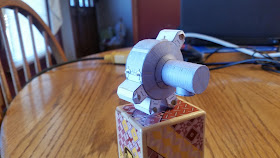The airlock consists of two segments - an equipment lock to store spacesuits and equipment and a crew lock where spacewalkers enter and exit. Astronauts involved in a spacewalk "camp out" in the airlock's equipment lock segment the night beforehand, breathing a low-nitrogen air mixture in order to purge nitrogen from their bloodstream as to avoid decompression sickness.
Four high pressure gas tanks (HPGT) (2x oxygen, 2x nitrogen) were originally installed along the outside radial edge of the equipment lock segment. A fifth HPGT (oxygen) was added by EVA-3 during STS-129 on November 23, 2009.
Quest is included as part of ISS combo kit #1 from AXM. All parts are contained on a single page. This article also covers the build of components added to the station shortly after Quest was added - the Early Ammonia Servicer (EAS) and Materials ISS Experiment (MISSE) 1-5 passive experiment containers (PEC). The EAS and MISSE parts are also contained on a single page that was graciously provided by AXM upon my request.
I started the build by first cutting out the Quest equipment and crew lock segments, taking care to get clean cuts on the "teeth" used to affix the end caps.
Next, I moved to assembly of the 5th HPGT. This tank is added much later in the build sequence during STS-129. To accommodate this delayed placement I affixed a magnet to the inside of the equipment lock hull at the prescribed location. I then built the HPGT, fabricated a bottom for the tank, affixed a mating magnet on the inside of the tank bottom. I extracted the hull covers included as part of the ELC-2 parts page and affixed them to the equipment lock hull to cover the part area.
I also affixed two magnets on the inside of the equipment lock hull at the locations where ESP-2 is eventually attached to the forward side of the airlock.
I then proceeded to build the ESP-2 attachment bracket and integrated the companion magnets that will be used to attach ESP-2 to Quest during STS-114.


I then assembled the end caps and placed a magnet segment on the forward starboard side of the equipment compartment to support magnetic attachment of the airlock spur which is added to the configuration during STS-110 EVA-4 on April 16, 2002.
Next, I assembled the crew lock, EVA hatch, and external EVA equipment cabinets base.
I affixed the end caps to the equipment lock. A magnet was placed on the inside of the port-facing end cap to accomodate magnetic mating to the Unity starboard berthing port.
I assembled the EVA equipment cabinets footholds and brackets. The foothold arms were fabricated from sections of fancy cocktail toothpicks. I colored the foothold arms using a bronze sharpie.
I then assembled the other four HPGTs.
Next, I placed another small piece of magnet on the inside of HPGT #2 to accommodate placement of MISSE-1 and MISSE-3.
I then joined the equipment and crew lock compartments together and affixed the EVA cabinets and HPGTs.
The MISSE PEC surfaces provided in the AXM parts kit are blank. Wanting to add realism, I embarked on a "Quest" to find images depicting the actual experiment configurations for each MISSE surface. After a bit of searching I found images for all five MISSE components on the NASA Langley MISSE site. I took screenshots of each surface and tinkered a bit to get the right scaling factor so that each image would properly fit within the area on each surface. I was quite pleased with the results of my labor!
I then turned my attention to fabricating the Early Ammonia Servicer (EAS). This refrigerator-sized 1,400 lb component was delivered to the station by STS-105. It was installed on the forward trunnion pin of the P6 truss on August 16, 2001 during an EVA. The component provided an ammonia reservoir in case a leak occurred during station coolant system assembly. The component was never used and was jettisoned overboard during an EVA on July 23, 2007.
The EAS parts were included on the same page as the MISSE PECs provided by AXM. The build consists of two hexagon-shaped cylinders, two end caps, and an attachment point and docking connection cone. I extruded the parts and assembled them based on visual reference photos of the component. I layered the grapple fixture added a wire segment to its center to enhance depth and realism. I added a magnet on the inside of the docking connection cone to promote easy attachment to the P6 trunnion pin.
Next, I moved back to Quest embellishments. I layered multiple segments to build up the keel pin area, drilled out the center using a hand drill and inserted a piece of insulated wire for the keel pin.
Next, I added trunnion pins and fitted the ESP-2 bracket to verify alignment. I fabricated a "dog bone" connector (toothpick segment with magnets at each end) to be used to connect Quest to the starboard berthing port of the Unity module. I used a neat Japanese puzzle box that I received from my brother-in-law for Christmas as the display base for the photos.
The build was now complete and ready for transport to my office. I carefully packed it up for its journey.
The component was then added to the existing configuration, first as depicted during STS-104.
And post STS-105 after placement of the EAS and MISSE-1 and MISSE-2.
Next up - Pirs. Stay Tuned!

















































